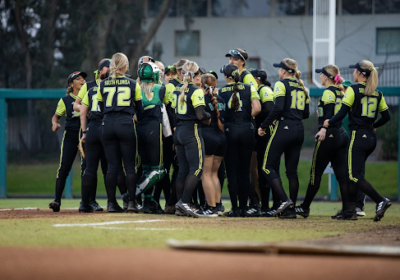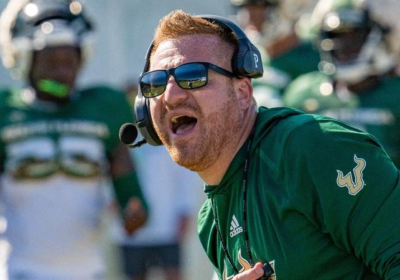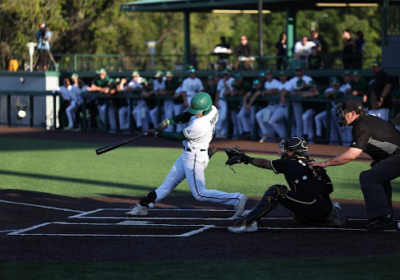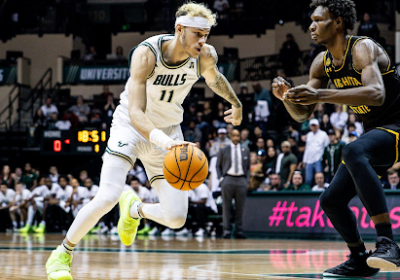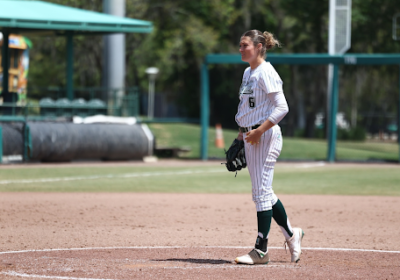Past struggles with scoliosis shapes SunDoll’s future

Melissa Gonzalez aspires to be a Bull all the way through medical school. SPECIAL TO THE ORACLE
It was supposed to be a routine physical examination, nothing more.
Instead, 12-year-old Melissa Gonzalez was overwhelmed when the doctor told her that she had scoliosis, a disorder that causes curvature of the spine. At the time, neither her nor her parents knew anything about the disorder or how much it would change their lives.
Gonzalez is currently scoliosis free following a successful surgery in 2015 and is a second-year member of the USF SunDolls dance team. Though dancing helped Gonzalez through her four years of having scoliosis, it was the struggle itself that impacted her future dreams the most.
“I’ve wanted to be a doctor for as long as I can remember,” Gonzalez said. “Then I wanted to be a surgeon. After my surgery, though, I knew that I really wanted to do pediatric orthopedic spine surgery. That way I can really share and commiserate with my patients as I help them through the process because it can be hard.”
For Gonzalez, the process was difficult from the minute she was diagnosed.
“Me and my parents were both freaking out when I found out because neither of us really knew what scoliosis was,” Gonzalez said. “I remember sitting and waiting for my X-ray that day and I was thinking, ‘Wow, what is my life about to be like?’”
Gonzalez couldn’t immediately fix the curvature in her back surgically because she was still growing, which meant there would be an increased risk of complication.
Scoliosis is most common in children aged 10-15, according to Webmd.com, with boys and girls developing the disorder at the same rate. Girls, however, are 10 times more likely to require treatment.
Since surgery was not the best option yet, the next three years of Gonzalez’s life were excruciating at times due to a pesky back brace that affected numerous aspects of her life.
“I was supposed to wear the back brace 23 hours a day,” Gonzalez said. “It was really painful and would leave scars on my back. My mom would come and sleep with me sometimes because I was so uncomfortable, I would do nothing but cry all night because it hurt so bad.”
Besides the physical pain and scars, Gonzalez was often embarrassed by the brace.
“Outfits would look funny on me because of (the brace). My shoulders would be un-even and the middle of the outfit would basically be on my side,” Gonzalez said. “I would wear a shirt, then the back brace, then another shirt on top of the brace that way people couldn’t see it.”
Gonzalez’s mom, Vickie Gonzalez, recalls all of the hardships the brace caused as well.
“She couldn’t wear normal clothes, so she had to wear baggy stuff since the brace covered her entire torso,” her mother said.
“It’d get so hot when she was sitting in class it’d give her back sores. She also couldn’t sleep at night. She would cry and say ‘Mommy can I not wear it tonight so I can get a good night’s sleep?’”
Though the pain was unbearable at times, Melissa pushed through.
Despite fears from her mother that the disorder would cause Gonzalez to become depressed, she remained positive and never stopped dancing.
“I never thought about quitting dancing because that’s what I love to do,” Gonzalez said. “My last few years at Tampa Catholic it was my goal to tryout and make it on the SunDolls, and I did, thankfully.”
After three long years of wearing a back brace everywhere, Gonzalez had a successful surgery at St. Joseph's Hospital that ended her scoliosis in summer 2015.
Gonzalez’s mother still remembers the exact date of the surgery and how nervous she was for the seven-hour procedure that would include two rods, 18 screws and a chain being placed into her daughter’s body.
“It was terrifying to have them wheel your healthy, happy daughter into the OR (operating room) not knowing what’s going to happen,” Vickie said. “They could’ve come out after the surgery saying that it didn’t go well. They could say that she couldn’t feel her legs or see. It was terrifying.”
After the surgery, there was a three-month recovery time for Gonzalez before she could dance again. The first two weeks were the toughest.
“For three months I couldn’t bend, lift or twist,” Gonzalez said. “I literally couldn’t do anything. I couldn’t even pick up a can of soda because it was too heavy. To pick up anything I had to squat down to do it.”
Her eagerness to start dancing again was apparent as she attended all her dance practices after the initial two weeks post-surgery even though all she could do was sit on the side – and do a couple stretches she wasn’t technically supposed to be doing.
Once she received clearance from her doctor, Gonzalez quickly went back to work on the dance floor and won an individual state dance competition just six months’ post-surgery.
While excelling in dance, she also maintained focus on her future goals by shadowing the same surgeon who operated on her. She now regularly shadows at St. Josephs and Florida Hospital Carrollwood.
Gonzalez kept her grades up throughout high school despite her condition. She earned principal’s honor roll every school year and was awarded the Florida Academic Scholars Award, the highest Bright Futures scholarship available to Florida high school students.
USF was the only school she applied to, and she will be a junior in credits next fall despite graduating high school a year ago.
She plans on dancing for the SunDolls as long as she can and hopes to stay at USF through medical school while she pursues her dream of becoming a pediatric spinal surgeon.
“She really enjoys helping people,” her mother said. “She has a sensitive side, and she loves to help children especially. She’s worked at a lot of different dance camps and she’s volunteered at St. Joseph's every summer since eighth grade. I think that really shows who she is as a person.”


